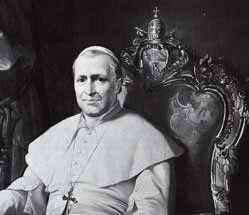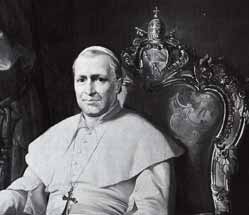The Church in the 19th century

 The historians recognize a strong religious component in the popular resistance of Catalonia to the Napoleonic invasion (1808-1814).
Nevertheless, at the exit of the Ancient Regime, the Church ascertained that there were big zones of the population that were not Catholics, or were it very superficially, and, following the new liberal ideas and the changes produced by the industrialization, they stood against her. It contributed to this also the cruelty and persistence of the Carlist wars. In 1835, for the first time in the history of Catalonia, there were popular killings of friars and creams of convents (that they will be repeated along the 19th century and at the beginning of the 20th and they will culminate in the big persecution of 1936).
The majority of the clergymen did not enjoy either the intellectual formation or the clairvoyance of Balmes and participated actively in the First Carlist War (1833-1840), especially the low clergy. For his side, the liberal government suppressed the religious orders and nationalized the ecclesiastical goods. In Catalonia, some 2.100 friars and some 1.300 nuns were expelled.
The Church lost immense material ballast, formed by possessions accumulated for seventeen centuries. This did not favor, however, the poor people or the farmers of these estates, but a small group of non Catholic bourgeoisies and without scruples (it was penalized with the excommunication) that went very low at prices to the public auction. How it is logical, the new owners you increased the rows of the enemies of the Church.
The Carlism won for the arms, a part of the hierarchy and of the intelligentsia Catholics took a position of negotiation with the Liberals -the majority of good faith, about everything the moderate ones-, overcoming the identification between absolutism and Catholicism, and looking for the way to continue their spiritual mission in the new conditions.
The spiritual and apostolic reaction of the Catholics was extraordinary. It started "the golden age" of the Church in Catalonia. In any moment of the history as the second half of the 19th century there has been so many saintly and Christians in process of beatification, nor so many institutions have been set up, singularly dedicated to the education and the charity, some of which have spread all over the world.
Saint Joaquima de Vedruna set up the Carmelites of the Charity in 1826; saint Paula de Montalt, Piarists, 1829; Lluís Masmitjà, the Daughters of the Heart of Maria, 1849; Pere Bach, the Felipnerises, 1850; Josep Tous i Soler, the Franciscans of the Mother of the Divine Shepherd, 1850); the beat Francesc Coll, the Dominican of the Annunciation, 1856; the inhabitant of Reus saint Maria Rosa Molas, the Sisters of the Consolation, 1857; the beat Francesc Palau i Quer, the Brothers and Sisters Carmelites, 1860-1861; saint Josep Manyanet, the Sons of the Holy Family, 1864, and the Daughter Missionaries of the Holy Family, 1874; saint Teresa Jornet, the Little Sisters of the old people, 1872; saint Enric d'Ossó, the Company of Saint Terese, 1876; Caterina Coromina, the Josephines of the Charity, 1877; the beat Manuel Domingo i Sol, the Fraternity of Diocesan Workers, 1884; the venerable Rosa Ojeda, the Carmelites of Saint Joseph, 1900.
Moreover, many religious institutes come from outside rooted there. It is the case, among of high, of the nuns of Jesus-Maria, set up in Lyons in 1818 and established in Catalonia in 1850.
On the other hand, a crowd of Catalan missionaries and missionaries spread out all over the world, like saint Peter Almató (martyr in Tonkin in 1861).
We can affirm that the Church undertook the Christianization in depth of the new society, especially through the family and of the school. She won the friendship of the majority of the tall bourgeoisie -that had been her main enemy from the Illustration- and of the classes medium, leaving a rest in hands of the freemasonry. The great majority of the proletariat remained pending, like in all Europe.
The process was a lot favored by the signature of the Concordat between Isabel II and the beat Pius IX, on 16 March of 1851. The Pope legitimated the moderate liberal monarchy before the Catholics and authorized them to collaborating with it -without because of that to discredit the Carlist ones-.
The concordat raised the excommunication to the bourgeoisies that had bought disentailed goods, considered it as good in exchange for a state budget for the clergy as long as the Church did not find a system of self financing, opened the return of the religious orders devoted to the education and to the charity, allowed the Church to acquire and to possess goods and promoted the reopening of the seminars and the creation in those dioceses where there was not.
Some of these seminars were doubled in a school, with which they educated simultaneously and in narrow relation the ecclesiastical futures and the laymen who prepared themselves for going to university and constituting the elites of the new society. The number of seminar’s grew hugely and determinate seminars, like that of Vic, climbed up the academic level and became intellectual institutions with great projection. Figures of first cultural line in the country appeared, like Balmes, Claret, Verdaguer or Torras i Bages.
The historians recognize a strong religious component in the popular resistance of Catalonia to the Napoleonic invasion (1808-1814).
Nevertheless, at the exit of the Ancient Regime, the Church ascertained that there were big zones of the population that were not Catholics, or were it very superficially, and, following the new liberal ideas and the changes produced by the industrialization, they stood against her. It contributed to this also the cruelty and persistence of the Carlist wars. In 1835, for the first time in the history of Catalonia, there were popular killings of friars and creams of convents (that they will be repeated along the 19th century and at the beginning of the 20th and they will culminate in the big persecution of 1936).
The majority of the clergymen did not enjoy either the intellectual formation or the clairvoyance of Balmes and participated actively in the First Carlist War (1833-1840), especially the low clergy. For his side, the liberal government suppressed the religious orders and nationalized the ecclesiastical goods. In Catalonia, some 2.100 friars and some 1.300 nuns were expelled.
The Church lost immense material ballast, formed by possessions accumulated for seventeen centuries. This did not favor, however, the poor people or the farmers of these estates, but a small group of non Catholic bourgeoisies and without scruples (it was penalized with the excommunication) that went very low at prices to the public auction. How it is logical, the new owners you increased the rows of the enemies of the Church.
The Carlism won for the arms, a part of the hierarchy and of the intelligentsia Catholics took a position of negotiation with the Liberals -the majority of good faith, about everything the moderate ones-, overcoming the identification between absolutism and Catholicism, and looking for the way to continue their spiritual mission in the new conditions.
The spiritual and apostolic reaction of the Catholics was extraordinary. It started "the golden age" of the Church in Catalonia. In any moment of the history as the second half of the 19th century there has been so many saintly and Christians in process of beatification, nor so many institutions have been set up, singularly dedicated to the education and the charity, some of which have spread all over the world.
Saint Joaquima de Vedruna set up the Carmelites of the Charity in 1826; saint Paula de Montalt, Piarists, 1829; Lluís Masmitjà, the Daughters of the Heart of Maria, 1849; Pere Bach, the Felipnerises, 1850; Josep Tous i Soler, the Franciscans of the Mother of the Divine Shepherd, 1850); the beat Francesc Coll, the Dominican of the Annunciation, 1856; the inhabitant of Reus saint Maria Rosa Molas, the Sisters of the Consolation, 1857; the beat Francesc Palau i Quer, the Brothers and Sisters Carmelites, 1860-1861; saint Josep Manyanet, the Sons of the Holy Family, 1864, and the Daughter Missionaries of the Holy Family, 1874; saint Teresa Jornet, the Little Sisters of the old people, 1872; saint Enric d'Ossó, the Company of Saint Terese, 1876; Caterina Coromina, the Josephines of the Charity, 1877; the beat Manuel Domingo i Sol, the Fraternity of Diocesan Workers, 1884; the venerable Rosa Ojeda, the Carmelites of Saint Joseph, 1900.
Moreover, many religious institutes come from outside rooted there. It is the case, among of high, of the nuns of Jesus-Maria, set up in Lyons in 1818 and established in Catalonia in 1850.
On the other hand, a crowd of Catalan missionaries and missionaries spread out all over the world, like saint Peter Almató (martyr in Tonkin in 1861).
We can affirm that the Church undertook the Christianization in depth of the new society, especially through the family and of the school. She won the friendship of the majority of the tall bourgeoisie -that had been her main enemy from the Illustration- and of the classes medium, leaving a rest in hands of the freemasonry. The great majority of the proletariat remained pending, like in all Europe.
The process was a lot favored by the signature of the Concordat between Isabel II and the beat Pius IX, on 16 March of 1851. The Pope legitimated the moderate liberal monarchy before the Catholics and authorized them to collaborating with it -without because of that to discredit the Carlist ones-.
The concordat raised the excommunication to the bourgeoisies that had bought disentailed goods, considered it as good in exchange for a state budget for the clergy as long as the Church did not find a system of self financing, opened the return of the religious orders devoted to the education and to the charity, allowed the Church to acquire and to possess goods and promoted the reopening of the seminars and the creation in those dioceses where there was not.
Some of these seminars were doubled in a school, with which they educated simultaneously and in narrow relation the ecclesiastical futures and the laymen who prepared themselves for going to university and constituting the elites of the new society. The number of seminar’s grew hugely and determinate seminars, like that of Vic, climbed up the academic level and became intellectual institutions with great projection. Figures of first cultural line in the country appeared, like Balmes, Claret, Verdaguer or Torras i Bages.
All rights reserved
Last update: 06/05/2016